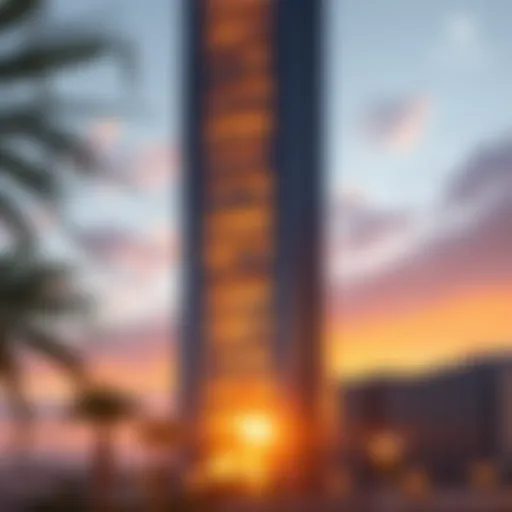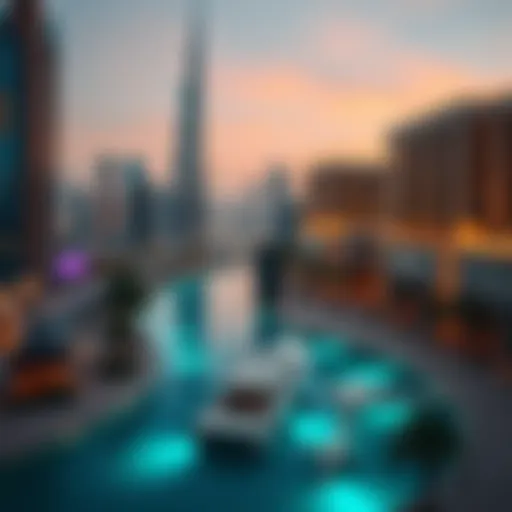Dubai Metro Station Progress and Future Plans in 2023
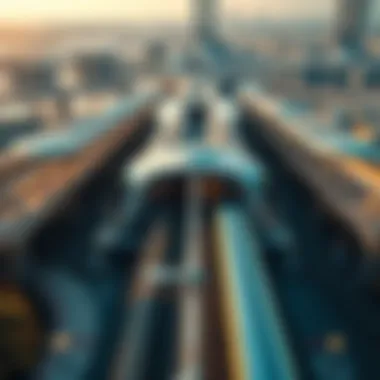

Intro
The Dubai Metro has seen remarkable transformation lately. In 2023, its ongoing projects and developments are reshaping not just urban infrastructure but also offering fresh opportunities for investment and housing. This development is a cornerstone for a city that has surged in global relevance over the past decades.
Integrating new routes and enhancing existing ones has not only improved connectivity between different parts of the expansive city, it also serves as a catalyst for real estate growth. With an increasing population, there is a pressing need for efficient public transport systems. The metro accommodates this demand efficiently, offering an answer to the daily hustle and bustle faced by both residents and tourists.
As we delve into this discussion, we’ll explore the various facets surrounding the metro's advancements, including its economic impact, market trends, and its role in urban development.
Market Trends and Insights
Current Market Analysis
The real estate market in Dubai has always danced to its own unique rhythm, but in 2023, the pulse is particularly strong around the Dubai Metro. With a robust investment influx and a broader reach, metro stations are becoming prime locations for housing developments. Major players in real estate are positioning themselves close to these stations, recognizing that they are gems, enhancing accessibility and appeal.
- Real estate investments near metro lines have risen approximately 15% in the past year.
- Developments within a 500-meter radius of station sites now command a premium, catering to both locals seeking convenience and expatriates attracted by the allure of urban living.
Historical Trends and Future Predictions
Historically, the Dubai Metro has been a reliable indicator of broader economic trends. Evidence from previous expansions shows a direct correlation between metro growth and property value increase, alongside the development of commercial spaces. Given this historical precedence, one can infer that the newly announced plans are not merely grand designs, but sound investments designed to further stimulate growth.
Looking ahead, projections suggest that as the metro continues to expand, there will be an additional rise of around 20-30% in property values, especially in less developed zones. The evolving landscape also indicates a push towards more vertical developments that cater to a business-oriented demographic willing to invest in smart living spaces, created to capitalize on both convenience and lifestyle.
"Investments in public transport typically lead to significant economic returns, for both the city and its investors. The Barcelona metro expansion in the early '90s is a case in point—driving urban growth for decades."
In just a matter of years, some neighborhoods previously overlooked are now finding themselves thrust into the limelight—thanks to thoughtful expansions in the transport network. For investors and homebuyers, this presents a golden opportunity.
Property Listings and Comparisons
Luxury Properties Overview
As easy access to metro networks elevates certain areas, luxury properties are emerging as hot commodities, attractive not just for affluent locals but also for international buyers. High-end apartments and modern villas are on the rise:
- Locations like Downtown Dubai and Dubai Marina are seeing high demand inspired by metro connectivity,
- Amenities now include proximity to stations, luxurious facilities like gyms and pools, and modern designs offering sweeping city views.
Affordable Housing Options
On the flip side, affordable housing is gaining traction as a viable option for young professionals and families. Several developers are focusing on creating budget-friendly housing solutions near metro stations. These properties come with competitive pricing and offer essential amenities, attracting a burgeoning middle class.
- Emerging neighborhoods such as Dubai Silicon Oasis are among the top contenders, offering practical housing choices while remaining close to metro lines.
- The integration of affordable solutions with opulent properties showcases a balanced real estate ecosystem designed to accommodate a wide range of income levels in a fast-evolving city.
Ultimately, the developments in the Dubai Metro station network echo broader trends in urban planning, real estate investment, and economic growth. Keeping an eye on these trends could be pivotal for potential investors, homebuyers, and real estate experts looking to thrive in this changing landscape.
For further in-depth details, you can explore resources like Wikipedia, Britannica or community insights on Reddit.
Preface to Dubai Metro
The Dubai Metro serves as the pulse of urban transportation in one of the fastest-growing cities globally. This highway under the ground is not just a mode of transport but also a symbol of Dubai's fiat to integrate modern infrastructure with sustainability and innovation. The significant uptick in the metro's utility over recent years reflects the city's progression toward urban mobility solutions. It's about connecting the dotted lines of city life, giving residents and tourists a seamless experience whilst commuting.
In this article, we will delve into the core aspects of the Dubai Metro, focusing on its overview and historical tapestry that weaves through the fabric of modern Dubai. Understanding the importance of the Metro in the urban landscape isn't just about seeing the shiny trains glide across the tracks; it's about appreciating how they change the lifestyle and economic horizons for millions.
Overview of the Dubai Metro System
The Dubai Metro boasts a robust network, covering many stretches that link key areas across the emirate. Officially launched in September 2009, the system rapidly became a major transportation preference in the city due to its efficiency and coverage. Today, it features over 75 kilometers of track and spans the Red and Green lines, delivering passengers from one part of the bustling city to another with ease.
This transit system is also noteworthy for its characteristics. It’s predominantly driverless, which is a rare feat and speaks volumes about Dubai's commitment to technological advancement. Moreover, the stations themselves are equipped with top-notch amenities, catering to passenger comfort with spacious waiting areas and retail spaces.
Historical Context and Development
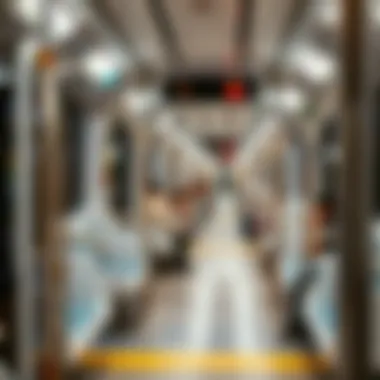
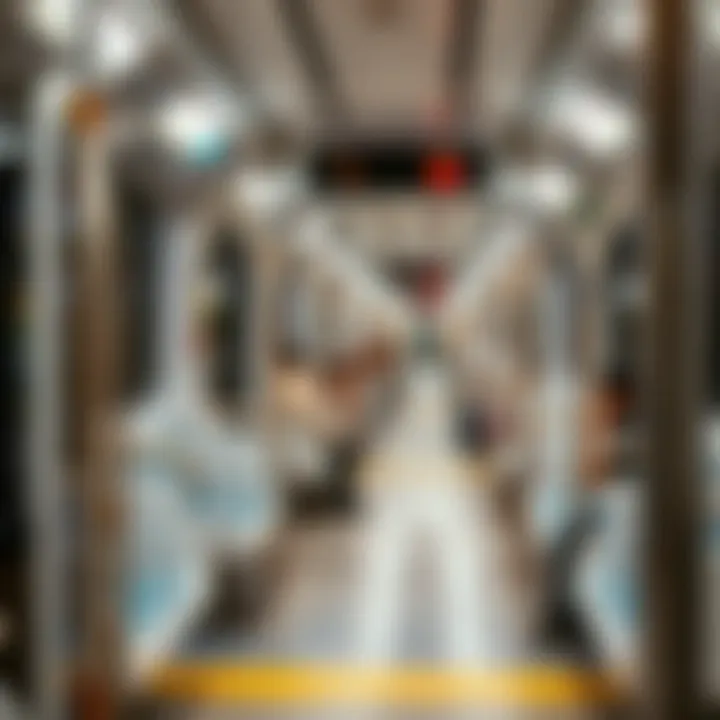
The roots of the Dubai Metro can be traced back to the early 2000s when Dubai began to recognize the impending challenges due to rapid population growth and urban expansion. The vision was clear: a smart, sustainable solution that would alleviate traffic congestion and reduce carbon emissions. By laying down the tracks of the Metro, Dubai took its first significant leap into modern transportation infrastructure.
Construction began in 2006, and the project was anything but straightforward. It required overcoming hurdles related to funding, technology, and land use. The government, however, was determined. Collaborations with global engineering firms and experts were made, and dizzying amounts of planning culminated in the launch of the first phase.
Each metro station embodies the architectural magnificence that characterizes Dubai. Many of them are not merely transit points but landmarks in their own right. As the metro network expanded, so did its influence on real estate developments, stimulating growth in neighborhoods that strived for accessibility.
In summary, the history of the Metro system is not just a story of tracks and trains; it's a tale of a city's commitment to future-proofing, a testament to innovation and growth in an ever-evolving global landscape. The metro now stands as a linchpin for economic activity, improving accessibility and supporting the connectivity needed for Dubai's residents and visitors alike.
Current Routes and Stations
Understanding the Current Routes and Stations of the Dubai Metro is crucial for grasping the impact of this urban transit system on Dubai's socio-economic fabric. The efficiency of a transport network largely hinges on its routes and stations—these are the veins and arteries of the city's connectivity. In 2023, the Dubai Metro has been underscored not only as a significant mode of travel but also as a pivotal element in shaping the urban landscape, promoting real estate growth, and encouraging sustainable urban living.
Detailed Analysis of Existing Lines
The Dubai Metro operates two primary lines: the Red Line and the Green Line, which cover a staggering 89 kilometers when combined. Each line has its own unique contributions to the urban mobility of the city. The Red Line runs from Rashidiya to UAE Exchange, connecting major districts such as Deira, Downtown Dubai, and Dubai Marina. It is a lifeline for both residents and tourists alike, and its stops are carefully choose to accommodate high-density areas.
- The Green Line stretches from Etisalat to Dubai Creek, serving areas that are often overlooked by traditional transport links. This line enhances accessibility to more localized hubs and neighborhoods, fostering more equitable growth.
Delving deeper, one cannot overlook the criticality of each station's location amid a backdrop of real estate development. For instance, the Dubai Mall station on the Red Line is not just a transportation hub; it has also spurred an economic boom in retail and hospitality sectors in its proximity.
In 2023, there have been discussions about optimizing not only the infrastructure but the frequency of services. Increasing operational hours and reducing waiting times stand out as strategies to better meet the demands of a growing population. This approach underscores the dynamic nature of the metro’s existence—constantly evolving to meet user needs.
Operational Efficiency and Connectivity
The operational efficiency of the Dubai Metro hinges on much more than just train schedules or remarkable engineering. It revolves around a web of multiple factors that include connectivity, user experience, and technological integration. Currently, the Dubai Metro operates at a 99% punctuality rate, which is no small feat in urban transport systems globally.
Connectivity is where the Dubai Metro truly shines. With more than 40 stations sprawled across the city, it provides seamless transfers to various other modes of transport, including buses, taxis, and the tram network. This interconnectedness significantly enhances mobility, making it easy for commuters to navigate urban challenges. There are even plans to integrate metro services with Dubai’s airports, streamlining travel for tourists and business travelers.
Moreover, as the metro develops and adds more lines in the future, the strategic placement of new stations will further enhance this web of connectivity. The synergy between public transport options can turn an entire city into a well-oiled machine.
In sum, the effectiveness of the Dubai Metro in 2023 exemplifies not only the current routes and stations but how they work in tandem to drive progress and opportunity across Dubai. Frequently, as one considers where to invest or live, these transport links offer a guiding light towards finding promising properties that align with future developments.
"New developments in transport shape not only how we move but also where we will choose to inhabit in the coming years."
As the city hustles forward, it becomes essential for interested investors, realtors, and developers to keep a close eye on how these routes evolve and influence land value—this is not just an urban transit system; it's a blueprint for Dubai's future.
New Developments in
The landscape of Dubai’s public transport is experiencing significant strides in 2023, largely due to the ongoing enhancements and ambitious projects associated with the Dubai Metro. These developments not only aim to improve commuter experience but also address the ever-growing population and tourism demands of the city. With an increase in routes, modernized stations, and best-in-class technology, the latest initiatives underscore the importance of a robust transportation network in sustaining urban growth. This section will illuminate the critical aspects of these developments.
Expansion Plans for Additional Lines
One of the cornerstones of the current initiatives involves expanding the existing metro network with new lines set to influence the daily commute of thousands. The planned Route 2020, which will extend the Red Line by about 15 kilometers and include seven new stations, is a keystone project completing the transport picture for the upcoming World Expo 2023.
The cabinet has expressed strong support for these expansions due to their potential economic benefits and their strategic role in connecting the central areas with emerging neighborhoods, thereby increasing accessibility for residents and investors alike. The integration of these lines into the wider master plan for the city reveals a foresighted approach to urban planning.
"By extending the metro, Dubai is not just investing in public transport but in a sustainable future for its communities," said a leading urban development analyst.
In addition to Route 2020, plans are underway for a Purple Line that will serve the underrepresented areas, tapping into regions that have seen rapid residential development but lack cohesive transport links. This will not only boost property values in those areas but also attract quality investments, which can lead to further developments.
Technological Innovations in the Metro
Moreover, technological innovations remain at the forefront of these expansion plans as the Dubai Metro aims to embrace the smart city ethos. AI-powered systems are being introduced to enhance operational efficiency and improve passenger experience. From real-time tracking to automatically adjusted frequencies based on demand, these technologies stand to revolutionize how users interact with the metro system.
One notable upgrade includes the implementation of a contactless payment system that simplifies the boarding process and minimizes crowding during peak hours. Additionally, the introduction of mobile applications enables passengers to plan their journeys more efficiently, incorporating live updates and route suggestions, which is especially beneficial for tourists.
The metro stations themselves reflect these advancements, embracing eco-friendly materials in new constructions and retrofits. By integrating green roofs and energy-efficient designs, the facilities not only reduce carbon footprints but also offer enhanced commuter comfort.
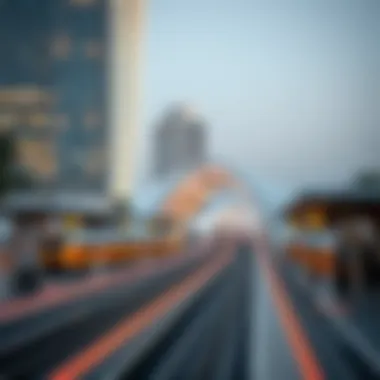

In this rapidly evolving urban environment, the combination of expansion and technology is not just about keeping pace with demand; it's about setting a standard for future developments. The upcoming enhancements promise to make the Dubai Metro not just a means of transportation, but a pivotal part of the city's commitment to sustainability and innovation.
Impact on Dubai's Real Estate Market
The influence of the Dubai Metro system extends far beyond its immediate function as a transportation network; it plays a pivotal role in shaping the real estate landscape in the bustling city. In 2023, as the metro continues to develop and expand, its impact on property values and investment opportunities becomes increasingly significant. Understanding this dynamic is crucial not only for potential homebuyers but also for investors, realtors, and developers.
Influence on Property Values Near Metro Stations
Proximity to a metro station has historically been a game changer for property values in cities worldwide, and Dubai is no exception. Properties located within a stone's throw of metro stations generally see a noticeable uptick in value. In 2023, with more stations opening and improving connectivity, this trend is expected to solidify even further.
For instance, research from local real estate agencies indicates that residential properties near the Downtown Dubai Metro Station have appreciated by nearly 15% in the last year alone. This increase can be attributed to enhanced accessibility, allowing residents to commute effortlessly to business districts and leisure spots. More importantly, the ease of access attracts a diverse demographic, from young professionals to families seeking a vibrant lifestyle.
Furthermore, properties in neighborhoods like Dubai Marina and Jumeirah Lakes Towers have also experienced a rise in demand due to their strategic locations near the metro. The careful planning of Dubai’s metro represents a thoughtful synergy between urban infrastructure and real estate, where location is king.
"Being close to a metro station not only means convenience but also serves as a solid investment strategy. It’s about securing value long-term."
Emerging Neighborhoods and Investment Opportunities
As the metro expands into previously underserved areas, new investment opportunities are cropping up, creating a ripple effect throughout the real estate sector. Neighborhoods that were once overlooked are now being primed for development, thanks to the increased accessibility provided by new metro lines.
Consider places like Al Quoz and Dubai Investment Park. These areas are experiencing a renaissance; developers are keenly aware of the forthcoming metro stations set to enhance the area's appeal. Projects in Al Quoz, particularly, are garnering interest from both commercial and residential sectors. Affordable yet strategically located, properties in these regions offer a lucrative option for investors thinking long-term.
The potential in these emerging neighborhoods is fueled not only by the metro but also by ongoing urbanization efforts. As schools, parks, and shopping centers spring up alongside new interchanges, the demand for housing is expected to flood in. For investors, this signals a golden opportunity to engage early in these markets, capitalizing on lower entry prices before property values skyrocket.
In summary, the Dubai Metro is not just a transit solution; it's a catalyst for change in the real estate market. Investors, realtors, and developers must keep a keen eye on these developments to harness the benefits they bring.
For more information on real estate trends and market analysis, you may visit Dubai Land Department or Property Finder.
These resources provide in-depth insights and data that can further guide decisions concerning property investments.
User Experience and Accessibility
The importance of user experience and accessibility in the Dubai Metro cannot be overstated. As a pivotal component of the city's transportation infrastructure, it serves not only to move people but also shapes their daily interactions with the urban landscape. Accessibility features ensure that all passengers, regardless of ability, can navigate the system with ease. The user experience includes everything from the physical design of stations to the technology employed in the metro.
Effective user experience enhances convenience. For example, well-marked signs, intuitive layouts, and fully operational ticketing systems contribute to a smoother journey. When passengers can easily find their routes and understand the schedules, the stress of commuting diminishes significantly.
In addition, incorporating elements that cater to differently-abled citizens is essential for fostering an inclusive environment. The Dubai Metro's commitment to these considerations not only complies with regulations but also demonstrates a forward-thinking approach to urban infrastructure.
Passenger Demographics and Usage Patterns
Passenger demographics reveal a rich tapestry of users. The metro serves a diverse population, including local residents, tourists, and expatriates. Understanding who uses the metro is crucial for tailoring services to meet the varying needs of these groups.
In 2023, data indicates a notable uptick in ridership among young professionals and students, likely influenced by various educational and business hubs positioned along the routes. Tourists also frequent the system, particularly those exploring major attractions such as the Burj Khalifa and Dubai Mall. This blend of daily commuters and casual riders influences peak times and service frequency.
- Key demographics include:
- Local residents commuting to work
- International visitors exploring the city
- Students accessing educational institutions
Examining the patterns of usage helps design future expansion strategies. For instance, increased ridership in specific areas encourages targeted improvements, such as additional trains during rush hours or enhanced connectivity to key destinations.
Accessibility Features for Differently-Abled Citizens
Accessibility features designed for differently-abled citizens reflect a significant commitment to inclusivity. The metro stations in Dubai have adopted best practices to ensure that individuals with disabilities can access services comfortably and securely. Features implemented include ramps, tactile guidance systems, and audible announcements, which cater to a range of physical and vision impairments.
The importance of these elements can't be overlooked. By making the metro accessible, Dubai promotes a more equitable transportation system that aligns with its progressive urban vision. Here are some notable features:
- Wheelchair Accessibility: Ramps and elevators are available at all major stations.
- Braille Signage: Information boards provide guidance for visually impaired passengers.
- Assistance Services: Staff are trained to assist passengers with special needs.
These initiatives don’t just comply with basic regulations; they foster an environment where all residents and visitors can move freely and enjoy the city. Accessibility is not merely a checkbox, but a fundamental aspect of urban transport, enhancing quality of life for everyone.
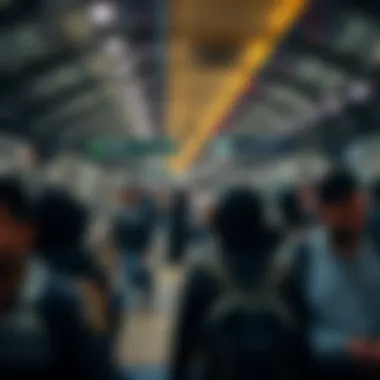

"Investing in user experience and accessibility means investing in the city’s future. It’s about ensuring that every person feels they belong in Dubai."
In summary, the focus on user experience and accessibility within the Dubai Metro enhances not just functionality but the overall urban experience, drawing in a wider demographic and fulfilling the city’s goal of being an inclusive global metropolis.
Sustainability Initiatives within Metro Operations
In the context of urban development, sustainability stands tall as a guiding principle, especially in a rapidly growing metropolis like Dubai. The sustainability initiatives embedded within the Dubai Metro operations not only underscore the commitment to environmental stewardship but also showcase how innovation can drive long-term benefits for both the planet and residents. As the municipal landscape continues to shift, embracing green practices in public transportation systems like the metro becomes indispensable. This is more than just a trend; it’s a necessity.
Eco-Friendly Technologies in Use
The Dubai Metro has consistently integrated advanced, eco-friendly technologies to minimize its ecological footprint. These technologies include energy-efficient trains that utilize regenerative braking systems, which convert kinetic energy back into electricity, reducing overall energy consumption. Furthermore, the metro stations employ solar panels that harness renewable energy for operational needs, thus aligning with the broader clean energy goals of the UAE. Additionally, the use of LED lighting throughout all metro facilities not only enhances visibility but also significantly cuts down on electricity usage.
One striking example of sustainability is the installation of green roofs at select stations, which aid in insulating buildings and reducing the urban heat island effect. Moreover, rainwater harvesting systems have been incorporated into the infrastructure to repurpose water for non-potable uses, such as landscaping. Each of these initiatives reflects a conscious effort towards an efficient and ecologically responsible metro system.
Contributions to Dubai's Green Economy Goals
The Dubai Metro's integration of sustainable practices directly supports the emirate's ambition to bolster a green economy. By championing public transport, the metro significantly reduces the reliance on cars, which are notorious for contributing to carbon emissions and other pollutants. This shift not only lowers the overall carbon footprint of the city but also contributes positively to air quality, thus enhancing the health and well-being of its citizens.
Investments in sustainable infrastructure also make economic sense. The efficiencies associated with eco-friendly technologies often translate into cost savings over time. This is particularly appealing to investors and developers who recognize that adherence to sustainability principles can increase property values and attract environmentally-conscious clientele.
"The future of urban mobility hinges on our capacity to embrace sustainability, making transportation systems like the Dubai Metro pivotal in achieving crucial environmental objectives."
Moreover, the Dubai Metro plays a central role in aligning with the UAE’s National Climate Change Plan, which emphasizes sustainable growth and the reduction of greenhouse gas emissions. As Dubai progresses towards hosting global events and reinforcing its status as a business hub, the focus on sustainable practices in public transport serves as a model for sustainable urbanization worldwide.
For those in the real estate and investment sectors, understanding the metro's commitment to sustainability offers insights into future urban development dynamics. With each green initiative, the Dubai Metro not only carves out a path toward a more sustainable urban environment but also sets a benchmark for similar initiatives across the globe.
Challenges and Future Outlook
The challenges and future outlook for the Dubai Metro system emerge as critical themes in understanding its role within the broader spectrum of urban transport. It isn’t just about how the metro operates today but also about how it can adapt to meet the evolving needs of a thriving metropolis like Dubai. The strategic importance of this discussion aligns closely with the interests of investors, realtors, and city planners who are keen on maximizing the urban development potential brought by the metro.
Operational Challenges Facing the Metro System
As the dubai metro system continues to expand, it faces several operational challenges that can affect its efficiency and attractiveness to users. One of the most pressing issues is the increasing demand for services. The population of Dubai is constantly growing, which places additional pressure on the existing infrastructure. Trains can get packed tighter than sardines during peak hours, making the experience less than enjoyable for riders.
Additionally, maintenance is an ongoing concern. Trains and tracks require regular upkeep to prevent delays and ensure safety. Aging infrastructure can be a problem if not kept in good condition, as it impedes reliability. Moreover, the integration of new technology adds another layer of complexity. While advancements are exciting, they demand training for staff and can lead to temporary disruptions during installations or upgrades.
"Sustaining operational efficiency amid rapid growth is crucial for the metro's long-term success."
Another challenge stems from the need for seamless connectivity with other modes of transport. Commuters often depend on multiple transit systems to complete their journeys. Inconsistent schedules or inadequate facilities for transferring between transport modes can hinder user satisfaction.
To address these hurdles, strategic investments in both technology and infrastructure are essential. Enhanced real-time data analytics can help manage the flow of passengers, while upgrades to stations can make transfers smoother.
Future Projections for Expansion and Usage
Looking ahead, the Dubai Metro is poised for significant expansion, with projections indicating a steady increase in both its reach and usage. Plans are underway to develop new lines and stations that will connect more neighborhoods, transit hubs, and commercial areas. This is where the potential for growth becomes apparent. Investing in these expansions not only meets immediate travel demands but also opens up opportunities for real estate development in previously underserved areas.
With the launch of smart transit technologies, future metro systems may lean heavily on automation and data analytics to improve service efficiency. Automated trains and predictive maintenance systems could drastically enhance the overall commuter experience, ensuring trains run just like clockwork.
Moreover, as the government pushes toward diversification and sustainability, expanding the metro network could align with the goal of decreasing reliance on cars, ultimately contributing to reduced traffic congestion and lower emissions.
In a nutshell, the future of the Dubai Metro appears bright, but intelligent investment and strategic foresight will be the keys to overcoming current challenges and ensuring that the system meets the needs of its users for years to come. Planning better routeswill not only make life easier for passengers but will also stimulate local economies and boost property values, creating a win-win situation for everyone involved.
The End
In summarizing the remarkable developments in the Dubai Metro system in 2023, it’s crucial to recognize the multifaceted nature of these advancements. The metro not only enhances connectivity across the emirate, but it also acts as a catalyst for economic growth and urban development. Investors, realtors, homebuyers, and developers must take careful note of the substantial benefits that come with improved transit systems like the Dubai Metro.
Summary of Key Findings
The insights gained from the ongoing enhancements in the Dubai Metro reveal several key findings:
- Expansion and Coverage: New lines and stations are being developed, significantly increasing the network's reach. This expansion can make housing in previously less accessible areas more attractive.
- Economic Impact: Property values near metro stations tend to rise, benefiting investors who are keen to capitalize on the increasing desirability of these locations.
- Sustainability Efforts: With eco-friendly technologies becoming integral to metro operations, the system contributes positively to Dubai's environmental objectives, appealing to socially-conscious investors.
- User Experience: Innovations in passenger services and accessibility procedures are enhancing the commuter experience, crucial for ensuring high usage rates in the long term.
Final Thoughts on the Metro's Role in Dubai
The Dubai Metro continues to play a pivotal role in shaping the city's urban landscape. As it evolves, its influence extends beyond mere transportation. The system represents a commitment to modernization and a willingness to invest in the future. Homebuyers looking for property values that intersect with growth need to pay attention to upcoming metro stations and lines.













